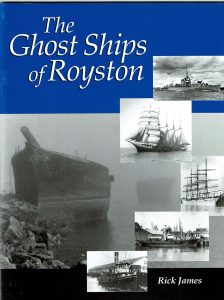Scattered along British Columbia’s inside coastal waters lay several collections of broken and rusted ships’ hulls. Many of these vessels had distinguished careers as warships, steam tugs, and Cape Horn windjammers. In a way, it is sad to look out over their broken remains and see them all so rotted away. Yet it is some consolation that they still serve a useful role as monuments to our West Coast’s rich maritime heritage. So how did they end up abandoned and left to be forgotten from as far back as the 1930s?
Here along the BC coast, timber harvesting companies usually dumped their logs into saltwater to be sorted and bundled into booms for towing off to sawmills or pulp and paper mills. Normally the companies chose protected coves or inlets for their log dumps but, on occasion, they were forced to operate in areas exposed to foul weather and strong winds. Logging outfits working out of Kelsey Bay and Royston along the inside waters of Vancouver Island, as well as Powell River over on the B.C. mainland, all used the stripped hulls of retired ships for protective breakwaters.
At Royston, located across the bay from the town of Comox, lies one of the most varied and unusual of these sites. It includes craft from the vanished days of commercial sail: a five-masted barkentine, a five-masted auxiliary schooner, along with three Cape Horn windjammers. Amongst its collection of steam and motor ships are four Royal Canadian Navy warships that saw service in the 2nd World War, two whalers, two Canadian Pacific Railway tugs, along with a deep-sea rescue tug and destroyer of the United States Navy that served in World War I. Together, these hulks represent a fascinating cross-section of West Coast maritime history.
 In 2004, the Underwater Archaeological Society of British Columbia published a comprehensive historical report on the graveyard titled The Ghost Ships of Royston in recognition of the significance of the site irregardless that all the vessels were actually beached hulks. Then in March 2011, a team from the UASBC and the U.S. based Institute of Nautical Archaeology conducted a series of exploratory dives and surveyed and mapped the graveyard’s remains.
In 2004, the Underwater Archaeological Society of British Columbia published a comprehensive historical report on the graveyard titled The Ghost Ships of Royston in recognition of the significance of the site irregardless that all the vessels were actually beached hulks. Then in March 2011, a team from the UASBC and the U.S. based Institute of Nautical Archaeology conducted a series of exploratory dives and surveyed and mapped the graveyard’s remains.
Soon afterwards, the “Royston Wrecks” were assigned protection under the British Columbia Heritage Conservation Act thereby declaring it to be a registered archaeological site. This makes it illegal for scavengers to take any souvenirs from the ships, while at the same time ensures that the hulks maintain their integrity as best as possible, which will allow further research and, more importantly, to continue on as an old ship graveyard to be admired by the public.
To order a copy of Ghost Ships of Royston, as well as other Underwater Archaeological Society of B.C. publications, visit their website. Also, another book of interest is Hulks: The Breakwater Ships of Powell River which documents the histories of the 19 ships that were used to form a floating breakwater to protect Powell River’s big pulp and paper mill’s log pond. This thoroughly researched publication, written by John Campbell a third generation Powell Riverite, can be ordered through Amazon.